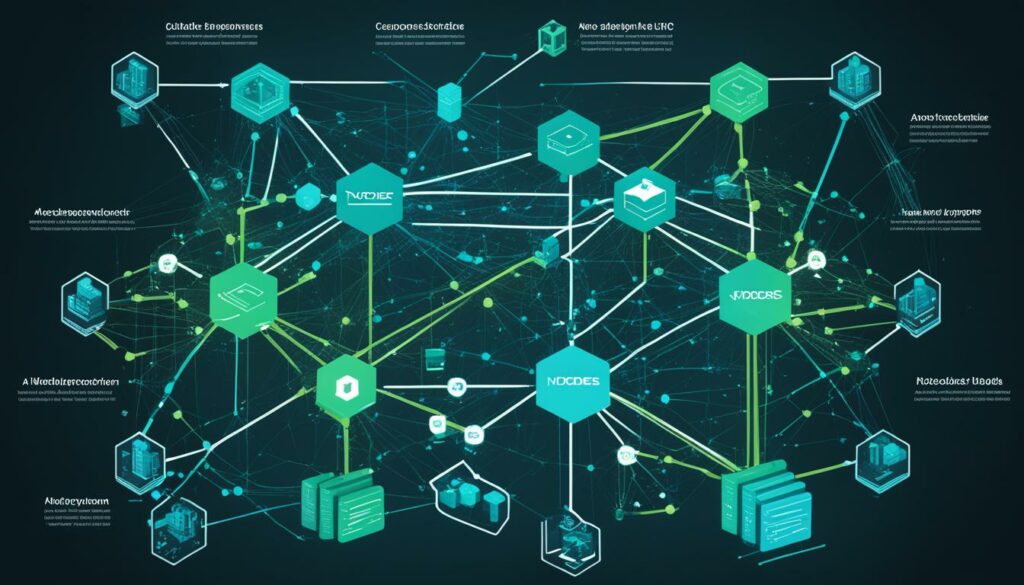Welcome to our comprehensive guide on microservices and hosting. In today’s fast-paced digital landscape, microservices architecture has revolutionized the way server-side code is developed and managed. By designing applications as a collection of loosely-coupled services that communicate over well-defined APIs, microservices offer numerous benefits such as easier development, maintainability, scalability, and improved network resilience.
In this article, we will delve into the key insights and best practices for microservices hosting. Whether you are already using microservices or considering adopting this architecture, understanding the fundamentals will help you make informed decisions to maximize the benefits of microservices hosting.
Key Takeaways:
- Microservices architecture accelerates software development and enables continuous delivery and deployment.
- Following the Single Responsibility Principle helps create maintainable and scalable microservices.
- Building cross-functional teams enhances collaboration and versatility in microservices development.
- Automating build and deployment processes with DevOps tools streamlines microservices management.
- Synchronous and asynchronous communication between microservices impacts application efficiency.
Understanding the Single Responsibility Principle for Microservices Design
The Single Responsibility Principle is a cornerstone concept in microservices design. It defines that each microservice should have a single, well-defined responsibility, avoiding the temptation to tackle too many tasks. By adhering to this principle, you can create applications that are maintainable, scalable, and easy to comprehend.
When each microservice has a clearly defined responsibility and is not tightly coupled to other services, the overall architecture becomes less complex to manage and test. Applying the Single Responsibility Principle helps to avoid scenarios where changes in one service affect the functionality or performance of unrelated services. This principle contributes to the overall maintainability and scalability of your microservices-based application.
“Each microservice should have one reason to change.”
– Robert C. Martin
Let’s take an eCommerce portal as an example. Instead of building a monolithic application, you can design separate microservices for different functionalities such as product listing, order management, customer management, payment processing, and more. Each microservice performs a specific task and can be developed, tested, and maintained independently without impacting other parts of the system.
The Single Responsibility Principle in Action
To further illustrate the benefits of the Single Responsibility Principle, consider the following scenario:
In a traditional monolithic application, a change in the product listing feature may require redeploying the entire application, including unrelated functionalities like order management and payment processing. This tightly coupled architecture often hampers maintainability and scalability.
However, by implementing microservices with the Single Responsibility Principle, you can enhance the application’s maintainability and scalability. If you need to update the product listing feature, you only alter the microservice responsible for product listing, minimizing the impact on other parts of the system. This streamlined approach reduces development and deployment cycles, increases efficiency, and allows for agile development practices.
Advantages of the Single Responsibility Principle
By embracing the Single Responsibility Principle in your microservices design, you can:
- Enhance application maintainability by isolating responsibilities and reducing interconnectedness
- Improve scalability by allowing independent development and deployment of individual microservices
- Foster team collaboration and specialization as each team focuses on a specific microservice and its associated responsibilities
- Facilitate testing and debug processes by isolating functionality within each microservice
Comparing Monolithic Applications and Microservices with the Single Responsibility Principle
| Aspect | Monolithic Applications | Microservices with Single Responsibility Principle |
|---|---|---|
| Deployment | Requires redeploying the entire application for any change | Allows independent deployment of individual microservices |
| Scalability | Difficult to scale individual functionalities | Enables independent scaling of specific microservices |
| Maintainability | Tightly coupled codebase makes maintenance challenging | Eases maintenance as changes are isolated within microservices |
| Development Agility | Changes can be time-consuming and impact unrelated functionalities | Facilitates rapid development, testing, and deployment cycles |
Implementing the Single Responsibility Principle enables you to harness the full potential of microservices architecture and build applications that are more resilient, scalable, and easier to maintain. By encapsulating clear and distinct responsibilities in each microservice, you create a more modular and efficient system that facilitates future enhancements and supports business growth.
Building Cross-Functional Teams for Effective Microservices Development
To develop a successful microservices architecture, it is essential to build cross-functional teams with clear responsibilities. These teams can be organized based on roles or functions, allowing them to handle their operations independently with versatility. For example, your organization could have UI/UX developers, front-end developers, back-end developers, database admins, QAs, and middleware developers all working together in a cross-functional team.
This approach facilitates better collaboration, enabling efficient bug fixing, new feature development, and smooth deployment in the production environment. With cross-functional teams, each member brings their unique expertise to the table, contributing to the overall success of the microservices development process.
These cross-functional teams play a vital role in the versatility of microservices development. Each team member specializes in their respective areas, ensuring that the development process is comprehensive and well-rounded. By leveraging the strengths of each team member, you can achieve a more robust and efficient microservices architecture.
“Collaboration among team members with different skills and expertise is crucial in microservices development. It fosters creativity, innovation, and problem-solving, ultimately leading to the delivery of high-quality applications.”
Benefits of Building Cross-Functional Teams in Microservices Development
- Improved Collaboration: Cross-functional teams allow developers from different domains to work closely, fostering collaboration and knowledge sharing.
- Better Bug Fixing: With a diverse team, bugs can be identified and fixed quickly through the collective expertise of individuals with different perspectives.
- Efficient New Feature Development: Cross-functional teams enable faster development of new features as different team members can work on different aspects simultaneously.
- Streamlined Deployment: Teams can deploy microservices independently, ensuring faster and more efficient release cycles.
Real-Life Example: Building a Cross-Functional Team for a Microservices Project
Let’s consider a real-life scenario of building a cross-functional team for a microservices project in an e-commerce company:
| Role | Responsibilities |
|---|---|
| UI/UX Developers | Create intuitive and user-friendly interfaces for the e-commerce platform. |
| Front-End Developers | Implement the UI/UX designs and ensure seamless user experiences. |
| Back-End Developers | Develop the core business logic, APIs, and microservices for the e-commerce platform. |
| Database Admins | Design and optimize databases to ensure efficient data storage and retrieval. |
| QAs | Test and validate the application to ensure high-quality and bug-free releases. |
| Middleware Developers | Build the necessary middleware components to integrate the microservices efficiently. |

By having a cross-functional team with these roles, the e-commerce company can develop, test, and deploy their microservices-based application more effectively. The clear division of responsibilities ensures that each team member can focus on their specialized area, leading to a more streamlined and efficient development process.
Automating Build and Deployment with DevOps Tools for Microservices
Automating build and deployment management is crucial for maximizing the value of microservices. By utilizing the right DevOps tools, frameworks, and libraries, you can simplify the implementation of a microservice architecture and achieve efficient and streamlined development, testing, deployment, and monitoring processes for your microservices-based applications.
Let’s take a look at some recommended DevOps tools that play a vital role in automating build and deployment in a microservices environment:
Jenkins

Jenkins is a popular open-source automation server that enables continuous integration and continuous delivery (CI/CD). It provides a robust environment for automating the build, testing, and deployment of applications. With Jenkins, you can set up automated pipelines that integrate multiple microservices, ensuring efficient collaboration and fast feedback loops during the development process.
Docker
Docker is a containerization platform that allows you to package your microservices and their dependencies into lightweight, portable containers. With Docker, you can easily isolate and manage each microservice as a separate container, enabling consistent deployment across different environments. The use of containers also promotes scalability, efficiency, and flexibility in your microservice architecture.
Kubernetes
Kubernetes is an open-source container orchestration platform that automates the deployment, scaling, and management of containerized applications. It provides a robust infrastructure for managing microservices at scale, enabling efficient resource allocation, load balancing, and fault tolerance. Kubernetes empowers organizations to deploy microservices across multiple clusters, ensuring high availability and resilience.
Monitoring and Observability
Monitoring is a critical aspect of microservices architecture. It helps you track the performance, availability, and health of your microservices in real-time. Tools like Logstash, Prometheus, and Grafana provide comprehensive monitoring and observability capabilities, allowing you to analyze logs, metrics, and traces. Effective monitoring enables proactive identification and resolution of any issues or bottlenecks in your microservices ecosystem.
In addition to the above-mentioned tools, there are many other DevOps tools and technologies that can enhance your microservices development and deployment processes. Some notable mentions include Postman for API testing, DevSecOps for managing the software development lifecycle, and GitHub for source code management.
By leveraging these DevOps tools, you can automate and streamline your build and deployment pipelines, enabling faster time to market, improved collaboration, and increased scalability in your microservices architecture.
Synchronous and Asynchronous Communication in Microservices
In microservices architecture, communication between services can take two forms: synchronous and asynchronous. Understanding the differences between these communication methods is crucial for designing efficient microservices.
Synchronous communication refers to a process where the user waits for a response before proceeding to the next step. This type of communication relies on immediate feedback, as each step is dependent on the completion of the previous one. While synchronous communication ensures that tasks are executed in a specific order, it can also introduce bottlenecks and delay the overall system performance.
On the other hand, asynchronous communication allows services to operate independently, completing tasks at their own pace without being hindered by dependencies on other services. This approach enhances efficiency as services can process requests concurrently, yielding faster response times and improved scalability. Async communication is particularly advantageous in situations where immediate feedback is not required, such as background processes, notifications, and data updates.
Maximizing Efficiency with Asynchronous Communication
In a microservices architecture, maximizing the use of asynchronous communication whenever possible is highly recommended. By reducing dependencies between services, organizations can achieve greater overall efficiency and scalability. This approach allows different microservices to operate autonomously, focusing on their specific tasks without being blocked by the response time of other services.
For instance, an eCommerce platform can employ synchronous communication for critical processes like user order processing, ensuring that the necessary steps are completed in a specific order. However, for non-critical tasks such as fulfillment notifications or inventory updates, asynchronous communication can be utilized. This way, the system can handle a large volume of requests efficiently, without causing delays or disrupting critical processes.

| Synchronous Communication | Asynchronous Communication |
|---|---|
| Requires immediate response | Does not require immediate response |
| Sequential execution | Concurrent execution |
| Potential bottlenecks and delays | Enhanced scalability and performance |
| Recommended for critical processes | Effective for non-critical tasks |
As depicted in the table above, asynchronous communication offers distinct advantages in terms of scalability, performance, and streamlined execution. By carefully designing the communication patterns within the microservices architecture, businesses can optimize their application’s performance and provide a smoother user experience.
Conclusion
Microservices architecture offers a flexible and scalable approach to application development and maintenance. By following best practices such as the Single Responsibility Principle, building cross-functional teams, automating build and deployment processes, and utilizing the right tools and technologies, you can harness the benefits of microservices hosting. This approach enhances performance, scalability, and agility in modern app development.
Embracing microservices architecture and implementing it effectively can lead to better software quality, increased speed, improved security, and overall success in the digital landscape. With a modular and decoupled architecture, you can easily scale individual components and handle high traffic loads without affecting the entire application. Microservices also enable rapid development cycles, allowing for frequent updates and deployments, which is essential in today’s fast-paced business environment.
When it comes to hosting microservices, there are various options available, including cloud hosting providers such as AWS, Azure, and Google Cloud. These providers offer scalable infrastructure, auto-scaling capabilities, and managed services, making them ideal for deploying and managing microservices. Additionally, containerization technologies like Docker and container orchestration platforms like Kubernetes simplify the deployment and management of microservices across different environments.
In conclusion, adopting microservices architecture combined with appropriate hosting solutions can significantly improve your application’s performance, scalability, and agility. By embracing the principles and best practices outlined in this article, you can unlock the full potential of microservices and drive innovation in your development process.
FAQ
Q: What is microservices architecture?
A: Microservices architecture is a modern pattern that involves designing and developing an application as a collection of loosely-coupled services that communicate over well-defined APIs.
Q: What are the benefits of microservices hosting?
A: Microservices hosting offers benefits such as easier development, maintainability, scalability, improved network resilience, and enables continuous delivery and deployment.
Q: What is the best hosting for microservices?
A: The best hosting for microservices depends on various factors, such as application requirements, scalability needs, and budget. Some popular microservices hosting providers include AWS, Google Cloud, Azure, and Heroku.
Q: How can cross-functional teams enhance microservices development?
A: Cross-functional teams allow for better collaboration, bug fixing, new feature development, and deployment in the production environment, resulting in more effective microservices development.
Q: Which DevOps tools are recommended for microservices build and deployment management?
A: Recommended DevOps tools for microservices build and deployment management include Jenkins, Bamboo, Docker, Kubernetes, Postman, Logstash, DevSecOps, and GitHub.
Q: What is the difference between synchronous and asynchronous communication in microservices?
A: Synchronous communication requires the user to wait for a response and advance through a series of steps, while asynchronous communication allows services to complete tasks without dependencies on each other, increasing overall efficiency.
Q: How can microservices hosting enhance performance and scalability?
A: Microservices hosting provides a flexible and scalable approach to application development and maintenance, resulting in improved performance, scalability, and agility in modern app development.












